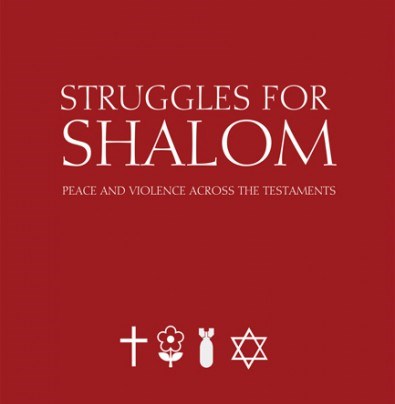The interplay between the concepts of peace and violence in the texts of the Hebrew Bible and the New Testament holds together the twenty-five essays found in Struggles for Shalom: Peace and Violence Across the Testaments. The volume honours the work of Mennonite scholars Perry B. Yoder and Willard M. Swartley, and was edited by Laura L. Brenneman (visiting lecturer at the University of Illinois in Urbana-Champaign) and Brad D. Schantz (doctoral student in Hebrew Bible at the University of Wisconsin-Madison), both of whom studied with Yoder and Swartley at Anabaptist Mennonite Biblical Seminary. The collection is divided into two parts, the first focusing on the Hebrew Bible and extra-biblical texts, and the second on the New Testament. Limitations of space preclude a thorough review of each contribution, so instead I will briefly note four essays which stood out from the rest (for reasons of quality, interest, or originality), then offer some remarks on the collection as a whole.
Laura Brenneman’s opening essay offers helpful insight into definitions of peace and violence. She discusses “positive” and “negative” descriptions of peace: the latter defining peace as the absence of violence; the former as the presence of such things as justice, wholeness, and health. This binary understanding of the term has shaped the understanding of biblical peace which has been the focus of much of the work of both Swartley and Yoder, and is thus of central importance to this collection as a whole.
Wilma Ann Bailey explores the translation of several passages in the Hebrew Bible, arguing that the worldview of the translators — most of whom were educated, wealthy, western Caucasian males — led them to “insert a greater degree of violence” into these texts than is present in the original Hebrew (47). Bailey claims that the interpreter’s faithfulness to the text demands an attempt to discern its meaning within a context of subjugation, lack of power, and desire for (and reliance upon) God’s deliverance.
Dorothy M. Peters offers a fascinating comparison between the Dead Sea Scrolls (DSS) community and sixteenth-century Anabaptists, both of whom espoused an ethic of nonretaliation. The essay first discusses the tension that exists in the DSS between present quietistic non-retaliation and the desire for vengeance against the enemies of the community, expressed through expectations of future judgmental violence. Peters then concludes with a brief exploration of similar themes at work in early Anabaptist communities.
For those who hold a theology of peace, Jesus’ words in Luke 22.35-38 are some of the most difficult to understand. This passage is discussed by Mary H. Schertz, who argues it must be understood within the progression of events narrated in vv. 31-62, centred around Jesus’ prayer in Gethsemane. Schertz contends that this moment represents the culmination of Jesus’ own struggle to discern God’s will regarding the establishment of the Kingdom, the means by which this will occur, and his own role in these events.
This is a woefully small sample of this volume, from which many other engaging and insightful contributions could be mentioned. Of course, in a collection of twenty-five essays there are bound to be some that are of higher quality than others. On the whole, however, the papers are well-written, interesting, and engage with the titular theme in thought-provoking ways. The diversity of the essays extends both to their methodology (ranging from the theological, to the conceptual, to the exegetical) and their subject matter (which includes overviews of scholarship, treatments of “problem passages,” and historical inquiry).
A great strength of this volume is the way in which nearly every one of these studies contribute to a richer understanding of the biblical term “peace” (shalom / eirēnē). Taken together, the essays demonstrate how multivalent this term is, its thematic prominence throughout both testaments, and, as a fundamental component of God’s restorative salvation, its centrality to the biblical narrative. Conversely, however, “violence” is not treated with the same thoroughness. Though implicit in the background of many of the essays (as the necessary “other” against which peace is held up), direct focus upon the term is lacking. Furthermore, what discussion there is of violence tends mostly to consider it in quite a straightforward manner (i.e., as the infliction of physical force or harm on another human) rather than with a more nuanced and abstract understanding of the term (the contribution of Reta Halteman Finger being an exception).
Finally, I wonder about the appropriateness of the volume’s subtitle: Peace and Violence Across the Testaments. Aside from the opening essay by Brenneman, there was basically no discussion of peace and violence “across” the testaments: that is, no paper offered any sort of explicit comparison of the biblical portrayal of peace (or violence) in the Hebrew Bible with that in the New Testament. Given that questions relating to this topic — e.g., how do we reconcile the clearly violent commands of Yahweh to Joshua and the Israelites during the conquest of Canaan with Jesus’ command to “love your enemies”? — are so often raised by readers of the Bible, layperson and academic alike, it would have seemed quite appropriate to include an essay which addressed this topic in some form, or at least to acknowledge the (apparent) discord. As it is, the collection is split quite cleanly between the two testaments, which leaves the reader without a sense of the overall canonical understanding of violence and peace.
However, it is always easier to critique a work for what it did not do rather than for what it did. The preceding comments, therefore, should not take away from the fact that this is a very worthwhile, engaging, and compelling collection of essays on an important and interesting theme within ancient Jewish and Christian texts. For anyone who is interested in the exegetical and theological aspects of peace and violence in the Hebrew Bible and the New Testament, Struggles for Shalom is highly recommended.
The Bottom Line: Struggles for Shalom is an important contribution to the study of peace and violence in the Bible. The collected essays address diverse and interesting questions related to this theme, and together make a compelling case that shalom is at the heart of God’s salvific work throughout the biblical narrative.
Review by Jesse Nickel (jessiahnickel@gmail.com)
University of St Andrews





1 Comment
Leave your reply.